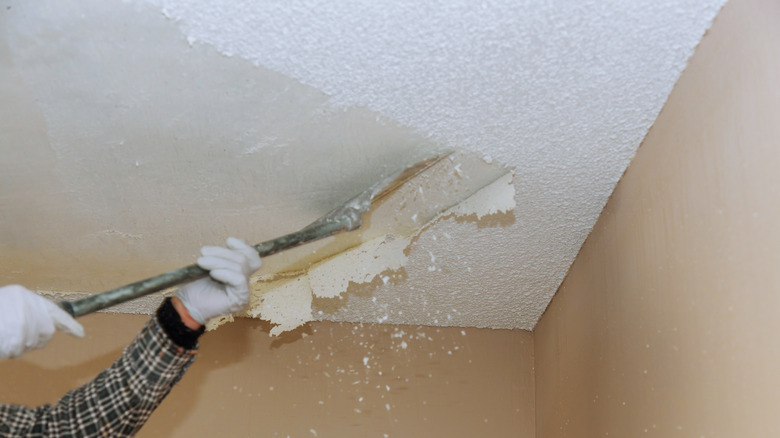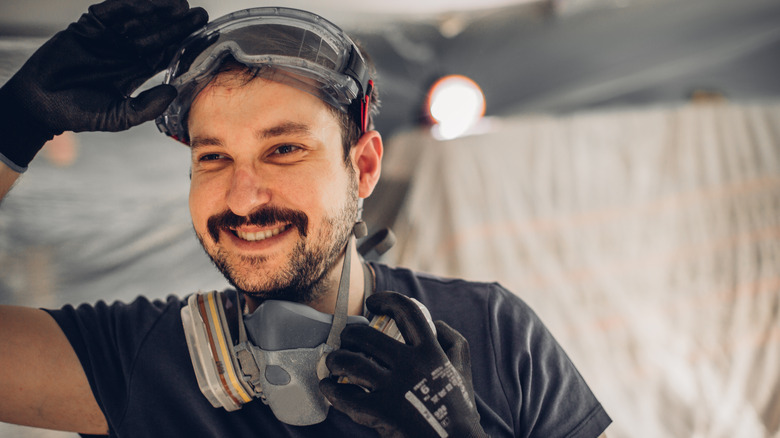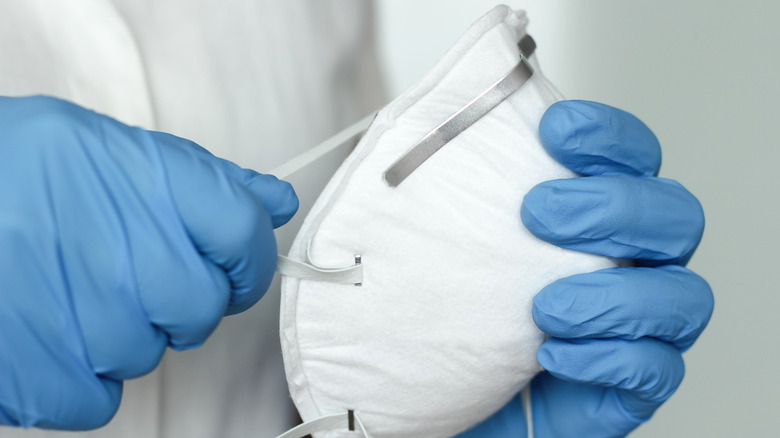Removing Popcorn Ceiling? Don't Forget This Protective Gear
We may receive a commission on purchases made from links.
Popcorn ceilings were popular all the way from the 1950s to the 1980s, giving us three decades of new-build homes and remodels filled with crunchy, textured ceilings. It not only gave the space a pop of texture, but it was an easy way to hide ceiling imperfections, whether they were uneven, discolored, or lumpy. While it might have been all the rage for multiple years, it has since firmly fallen out of favor. And if someone buys a house with a popcorn ceiling still intact, they're usually in a rush to remove it. While it's simple enough to do, it's imperative that you wear protective gear to protect your skin, eyes, and lungs from debris. However, while most people put on a pair of gloves and strap on a pair of goggles, they often forget to wear a mask.
This might be because it is recommended to wear a mask if removing a popcorn ceiling with asbestos. Most houses with popcorn ceilings built before 1980 have asbestos, and to remove it safely, you need to wear protective gear such as plastic gloves, goggles, overalls, and a respirator. Because of this, people might assume that wearing a mask to remove non-contaminated popcorn texture is overkill. But it's actually very important. Here is why.
Why you have to wear a mask when removing popcorn ceilings
Even if your popcorn ceiling tested negative for asbestos, it is important to wear a mask. According to painting and removal companies, the reason for this is that you will still be scraping off drywall. The drywall dust will go airborne once you do so, causing thousands of tiny particles to get kicked up and float around. Without proper gear, you will breathe in this dust, which can cause adverse health effects. According to the CDC, this includes throat irritation, coughing, and asthma-like symptoms.
To avoid this, you need protective gear — but not just any mask will do. Specifically, professionals recommend wearing a respirator for ultimate coverage, but a dust mask will do in a pinch. A respirator mask — or a reusable half mask — provides ultimate protection since it has special filter-covered valves that remove dust or debris from the air you breathe. The filters are replaceable, and the mask itself is often made from rubber, ensuring a tight seal against your face. A dust mask, on the other hand, is a little less intense. Also called a Filtering Facepiece Respirator (FFR), it's made from a filtering cloth rather than rubber, and sits looser on the face. Because of this, it's more comfortable, but also a little less effective. According to the CDC, some studies show that it reduces dust by 67%. While it might not be as effective as a respirator mask, many popcorn removal companies recommend using it.
What kind of masks to buy
If you have a popcorn ceiling that desperately needs scraping, you might be in the market to buy such masks. If you want to play it safe and invest in a respirator mask, a good one to try is the 3M Half Face Respirator 7500-Series. It sells for $30 at Ace Hardware, and it is made out of silicone rather than rubber to make it more comfortable for extended wear. The seal won't be as harsh on your face. It has two filtered valves on either side of the mask, helping block any dust and particles from entering your nose or mouth.
For those looking for a simpler dust mask, you can get a 20-pack of 3M's N95 Drywall Sanding Disposable Respirators for $28 at Home Depot. These are NIOSH-approved, which means the National Institute for Occupational Safety and Health approved their design and confirms that they will protect your airways sufficiently. These particular masks are 95% effective at filtering particles, which would be great for your DIY reno.


